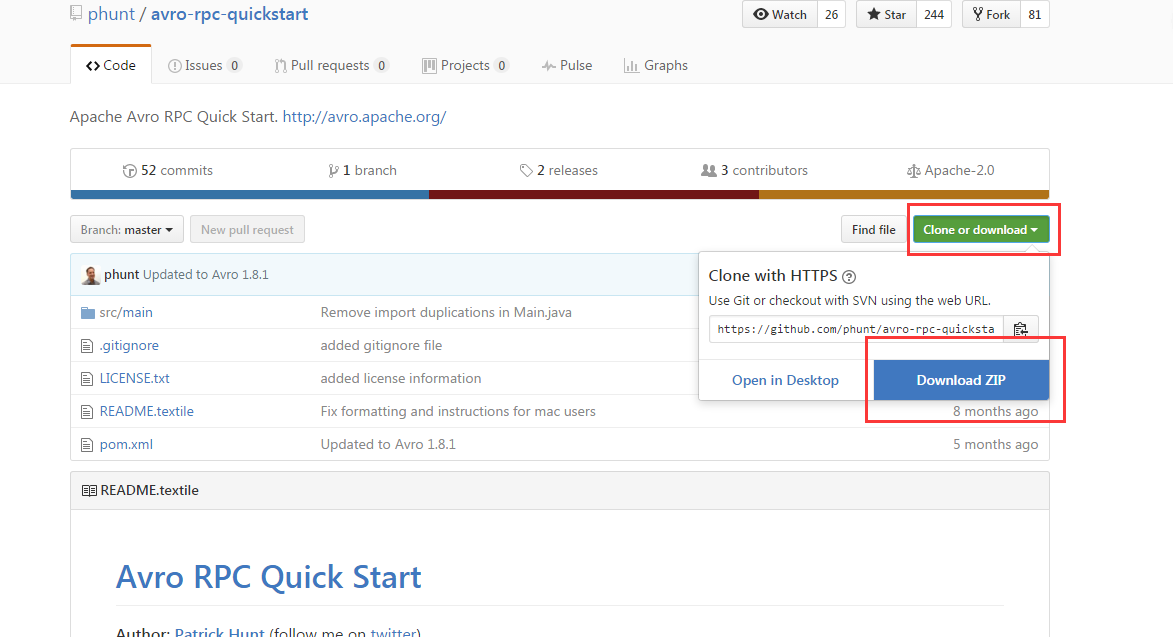本篇内容基于《hadoop权威指南(第三版)》内容。我在实现书中源代码的时候会出现一些错误(我在windows平台下测试),这里做了一些改进,同时我也想在书中内容的基础上了解更多AVRO的信息,所以写这个笔记对自已学习的内容有一个记录,方便以后使用。(本文所有代码见https://github.com/alphg/avro_study)
1、JAVA序列化
建议大家先阅读http://www.cnblogs.com/xiohao/p/4234184.html 了解基本的java序列化的方法和序列化的作用
2、Hadoop Writable接口
2.1、Intwritable 测试
hadoop序列化格式是writable,我们以Intwritable为例来对期进行简单了解。
common.java 定义一些简单的序列化公共函数
package com.java.study.serial;
import org.apache.commons.io.output.ByteArrayOutputStream;
import org.apache.hadoop.io.Writable;
import java.io.*;
/**
* Created by 410s on 2016/10/14.
*/
public class Common {
//序列化到内存
public static byte[] serialize_byte(Writable writable) throws IOException {
ByteArrayOutputStream out=new ByteArrayOutputStream();
DataOutputStream dataout=new DataOutputStream(out);
writable.write(dataout);
dataout.close();
return out.toByteArray();
}
//从内存中反序列化
public static void deserialize(Writable writable,byte[] bytes) throws IOException {
ByteArrayInputStream in=new ByteArrayInputStream(bytes);
DataInputStream dataIn=new DataInputStream(in);
writable.readFields(dataIn);
dataIn.close();
}
//序列化到文件 将文件存到D:\\a.txt中
public static void serialize_file(Writable writable) throws IOException {
FileOutputStream out=new FileOutputStream("D:\\a.txt");
DataOutputStream dataout=new DataOutputStream(out);
writable.write(dataout);
dataout.close();
out.close();
}
//从文件中进行反序列化
public static void deserialize_file(Writable writable) throws IOException {
FileInputStream in=new FileInputStream("D:\\a.txt");
DataInputStream dataIn=new DataInputStream(in);
writable.readFields(dataIn);
dataIn.close();
in.close();
}
}WritableTest.java
import com.java.study.serial.Common;
import com.java.study.serial.PersonWritable;
import org.apache.hadoop.io.*;
import org.testng.annotations.Test;
import java.io.IOException;
import java.util.Date;
import java.util.EnumSet;
import java.util.Iterator;
/**
* Created by 410s on 2016/10/14.
* intwritable 测试
*/
public class WritableTest {
public static void main(String[] args) throws IOException {
IntWritable writable=new IntWritable(163);
Common.serialize_file(writable);
}
@Test
public void test_IntWritable_file() throws IOException {
//声名一个Intwritable对象,并将其值设置为163
IntWritable writable=new IntWritable(163);
//将其序列化输出到文件当中
Common.serialize_file(writable);
//构造一个新的对像
IntWritable writable2=new IntWritable();
//反序列化
Common.deserialize_file(writable2);
//输出writable2中的值,看其是否与我们序列化的值相同
System.out.println(writable2.get());
}
}运行测试文件我们可以看到输出的值是163,与我们序列化的值相同。
2.2 定制writable
在我们编写Mapreduce程序时,常常需要定制writable,实现我们自已的序列化类。
PersonWritable.java
package com.java.study.serial;
import org.apache.hadoop.io.*;
import java.io.DataInput;
import java.io.DataOutput;
import java.io.IOException;
/**
* Created by 410s on 2016/10/14.
*/
public class PersonWritable implements WritableComparable<PersonWritable> {
private Text userName=new Text();
private IntWritable age=new IntWritable();
private DoubleWritable account=new DoubleWritable();
private BooleanWritable status=new BooleanWritable();
private LongWritable createTime=new LongWritable();
private MapWritable configs=new MapWritable();
public PersonWritable() {
}
public PersonWritable(Text userName, IntWritable age, DoubleWritable account, BooleanWritable status, LongWritable createTime, MapWritable configs) {
this.userName = userName;
this.age = age;
this.account = account;
this.status = status;
this.createTime = createTime;
this.configs = configs;
}
public int compareTo(PersonWritable o) {
return 0;
}
public void write(DataOutput out) throws IOException {
userName.write(out);
age.write(out);
account.write(out);
status.write(out);
createTime.write(out);
configs.write(out);
}
public void readFields(DataInput in) throws IOException {
this.userName.readFields(in);
this.age.readFields(in);
this.account.readFields(in);
this.status.readFields(in);
this.createTime.readFields(in);
this.configs.readFields(in);
}
@Override
public String toString() {
String str=this.userName.toString()+"\n"
+this.getAge().get()+"\n"
+this.getAccount().get()+"\n"
+this.getCreateTime().get()+"\n";
Set<Map.Entry<Writable,Writable>> keys=this.configs.entrySet();
Iterator<Map.Entry<Writable, Writable>> it=keys.iterator();
while(it.hasNext()){
Map.Entry<Writable,Writable> tmp=it.next();
str+="{"+tmp.getKey()+":"+tmp.getValue()+"}";
}
return str;
}
public Text getUserName() {
return userName;
}
public void setUserName(Text userName) {
this.userName = userName;
}
public IntWritable getAge() {
return age;
}
public void setAge(IntWritable age) {
this.age = age;
}
public DoubleWritable getAccount() {
return account;
}
public void setAccount(DoubleWritable account) {
this.account = account;
}
public BooleanWritable getStatus() {
return status;
}
public void setStatus(BooleanWritable status) {
this.status = status;
}
public LongWritable getCreateTime() {
return createTime;
}
public void setCreateTime(LongWritable createTime) {
this.createTime = createTime;
}
public MapWritable getConfigs() {
return configs;
}
public void setConfigs(MapWritable configs) {
this.configs = configs;
}
}
在WritableTest.java中添加如下测试函数
@Test
public void test_PersonWritable_file() throws IOException {
PersonWritable person=new PersonWritable();
person.setUserName(new Text("administrator"));
person.setAge(new IntWritable(20));
person.setAccount(new DoubleWritable(100.23));
person.setStatus(new BooleanWritable(true));
person.setCreateTime(new LongWritable(new Date().getTime()));
MapWritable configs=new MapWritable();
configs.put(new Text("index_style"),new IntWritable(1));
configs.put(new Text("hompage"),new Text("index.html"));
person.setConfigs(configs);
Common.serialize_file(person);
PersonWritable person2=new PersonWritable();
Common.deserialize_file(person2);
System.out.println(person2.toString());
}结果我们看到我们成功输出了对象person中的值。
2、简单AVRO实例
修改pom.xml添加以下代码
<dependency>
<groupId>org.apache.hadoop</groupId>
<artifactId>hadoop-common</artifactId>
<version>2.7.3</version>
</dependency>StringPair.avsc内容
{
"type":"record",
"name":"StringPair",
"doc":"A pair of strings.",
"fields":[
{"name":"left","type":"string"},
{"name":"right","type":"string"}
]
}JAVA代码
public void test_1(){
Schema.Parser parser=new Schema.Parser();
try {
File f=new File("D:\\Workspace\\java\\hbase\\src\\main\\resources\\StringPair.avsc");//StringPair.avsc文件的绝对路径
InputStream in=new FileInputStream(f);
Schema schema= parser.parse(in);
GenericRecord datum= new GenericData.Record(schema);
datum.put("left","L");
datum.put("right","R");
ByteArrayOutputStream out = new ByteArrayOutputStream();
DatumWriter<GenericRecord> writer =
new GenericDatumWriter<GenericRecord>(schema);
Encoder encoder = EncoderFactory.get().binaryEncoder(out, null);
writer.write(datum, encoder);
encoder.flush();
byte[] bytes=out.toByteArray();
System.out.println(new String(bytes));
out.close();
} catch (Exception e) {
e.printStackTrace();
}
}执行结果
可以看到控台输出 L R
3、avro-rpc-quickstart
本文参考AVRO文档中推荐的 avro-rpc-quickstart,原文网址
https://github.com/phunt/avro-rpc-quickstart
排除其中所有的英文介绍不谈,运行这个实例的方法很简单
安装配置MAVEN
安装配置MAVEN的方法大家可以参考下面网址
http://www.cnblogs.com/quanyongan/archive/2013/04/17/3025971.html(推荐大家使用第二种方法,进行下图中所示的两步就可以,关于ECLIPSE部分可以不操作。)
运行测试代码
按照下图所示下载整个工程的的ZIP压缩文件

解压上述ZIP文件,打开命令提示符(CMD),切换当前目录至文件解压后的位置。
cd C:\Users\410s\Desktop\avro-rpc-quickstart-master
mvn compile
mvn -e exec:java -Dexec.mainClass=example.Main -Dexec.args="avro_user pat Hello_World"
如果没有出错的话大家应该可以看到下面结果
收集
http://blog.csdn.net/xxd851116/article/details/25197373 解决Maven报Plugin execution not covered by lifecycle configuration
























 289
289

 被折叠的 条评论
为什么被折叠?
被折叠的 条评论
为什么被折叠?










